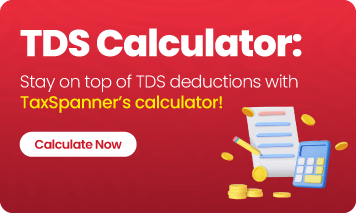TDS Return for Salary: A Comprehensive Guide for Employers
Tax Deducted at Source (TDS)
TDS is a method of income tax collection in India where the payer deducts taxes directly at the source of the individual's income. The Income Tax Act of 1961 governs TDS provisions on salary, with the Central Board of Direct Taxes (CBDT) administering the policies related to TDS in India.
TDS on Salary
Section 192 of the Income Tax Act of 1961 says that Tax Deductions on Salary (TDS) are deductible on salary income. Based on the employee's net taxable salary, employers deduct TDS on their behalf and submit it to the income tax authorities. This system ensures the government gets its money on time, enabling taxes to be collected as soon as money is received. TDS is shown on Form 16, which is released yearly. This form allows taxpayers to determine their tax liability at the end of the financial year and adjust TDS in order to settle any outstanding balances or claim a refund of taxes. Suppose an employee's annual salary exceeds the basic exemption limit. In that case, their employer is legally obligated to deduct TDS. Form 16 is necessary to file income tax returns and acts as proof of TDS deductions. Employers need to submit the amount of TDS that has been deducted to the government within the specified time.
Components of salary
Salary for TDS deduction is calculated as the gross salary paid by the employer, excluding tax-free exemptions and deductions. It includes basic pay, Dearness allowance, other allowances, perquisites, EPF contributions, bonuses, commissions, gratuity, and annuity payments. Salary includes basic pay, HRA, LTA, meal allowance, perquisites, EPF contributions, bonuses, commissions, and other benefits.
Calculation of TDS on salary
The annual compensation, which comprises base pay, allowances, perks, perquisites, etc., is initially determined by the employer.
The employer calculates the net taxable salary and deducts TDS from it in order to calculate TDS. Then, to get the net salary income, the tax-free allowances and exemptions are subtracted from the gross salary. After that, the salary income would be subtracted if you claimed tax-saving investments along with expenses that fall under Sections 80C, 80D, or other sections. If you file any extra income, it is added to your salary. The TDS amount is then deducted, which is based on the slab into which your net taxable income is categorized.
Employer obligations
First, obtain a Tax Deduction Account Number (TAN); tax from salaries must be deducted and deposited into the government within a specified timeframe. Employers must issue Form 16 to employees, which contains the amount of salary paid and deducted TDS. They must also file quarterly TDS returns using Form 24Q, which provides details of deducted and deposited TDS and is important for reconciling TDS certificates provided to employees. Failure to do so can result in penalties.
Implications of TDS if there are multiple employers
When you switch jobs and receive salary income from multiple employers, each employer calculates and deducts TDS according to your income and investment information. However, if you submit Form 12B to your new employer, the employer calculates TDS considering the TDS deducted by the previous employer, preventing any confusion in TDS rates and ensuring a smooth and seamless deduction on your income. Form 12B contains details of your previous employer's salary and the amount of TDS deducted.
Employee's obligations
Form 16 is a TDS certificate provided by employers to their employees at the end of the financial year, which is really important for filing income tax returns. It provides detailed information on salary earned and TDS deducted. Employees should file their returns before the due date to avoid penalties and serve as proof of income and Tax paid.
Things to do for Employees
- Employees should be vigilant and well-informed about Tax Deducted at Source (TDS) during the annual tax filing season. To ensure proper TDS deductions, employees should check and verify their Permanent Account Number (PAN) details, Form 16, TDS amount, income tax slab rates, investment proofs, claim refunds, tax-saving investments, Form 26AS, and non-salary TDS.
- Ensure that your employer has the correct PAN details, as a mismatch can result in higher TDS deduction rates and complications during tax filing. If you have declared investments under sections like 80C, 80D, 80E, or others, submit the necessary investment proofs on time to avoid extra deductions.
- Claim refunds can be claimed if too much TDS has been deducted due to not accounting for eligible deductions. Tax-saving investments and expenditures should be taken into account when calculating TDS. Check Form 26AS, a consolidated tax statement on the Income Tax Department's website, to ensure all TDS credited against your PAN is reflecting correctly.
- Ensure that non-salary TDS for income from other sources, such as interest from bank deposits or rent, is also correctly reflected in Form 26AS. If you notice discrepancies in TDS amounts or related details, contact your employer's HR or finance department immediately.
- For future refunds, update your personal information with the Income Tax Department, including your bank account information and contact info. Determine whether special allowances and perks, such as leave travel allowance (LTA) and house rent allowance (HRA), have been correctly included in TDS calculations. Stay updated on changes that could impact TDS deductions when the budget is released.
TDS on Salary vs. Other TDS
TDS is not only deducted from salaries; it is also deducted from a number of other income sources, including dividends, interest on securities, and lottery winnings. The requirements and rates are different, though. TDS is deducted from salaries in accordance with income tax slabs; laws regarding taxes define other rates for other sources.
When is salary income eligible for TDS deductions?
TDS is deducted from the salary when it is received. When your salary accrues, that is, when you are making money, but your company is not paying it, it is not deducted. Furthermore, TDS would be subtracted from any advances you receive on your pay or lump sum payments made by your company to cover the outstanding balance. TDS, however, would not be deducted from your salary income if your taxable salary is less than the tax level.
Calculation of TDS rate by employer
The employer calculates the TDS amount at the start of each financial year based on the employee's salary and available deductions and exemptions. If an employee switches jobs, the TDS is calculated from the date of joining the organization. The deduction on salary can be calculated using the formula;
Income Tax Rate = Income Tax Payable / Estimated Revenue.
Reduce TDS on Salary
- Employees have a choice of tax-saving options such as the Equity Linked Savings Scheme (ELSS), National Savings Certificate (NSC), Public Provident Fund (PPF), and tax-saving FDs.
- Chapter VI A of the Income Tax Act of 1961 provides various deductions that can help lower the TDS rate deducted by the employer. These deductions include Section 80C, which allows deductions up to INR 1.5 lakhs for investments in eligible avenues or incur qualified expenses during a financial year, such as life insurance premiums, ELSS investments, Sukanya Samriddhi Yojana, Senior Citizen Saving Scheme, NPS, PPF, EPF, tuition fees, home loan repayment, stamp duty paid on a property, and NSC.
- Section 80D allows deductions for health insurance premiums, with a maximum limit of Rs. 25,000 for individuals who are below 60 years and Rs. 50,000 for senior citizens. Section 80CCD (1B) gives an additional deduction of up to INR 50,000 for investments in the National Pension System. Section 80TTA allows tax-free interest income earned on a savings account up to INR 10,000.
- Section 89 allows a reduction in tax liability through marginal relief for employees of companies, governments, universities, local authorities, cooperative societies, associations, or bodies. Employees can claim marginal relief on Tax by filling out and filing Form 10E on the income tax department's website.
- Employers must issue TDS statements after deducting applicable TDS from salary, which are given out in Form 16 after the end of the financial year but before the tax filing deadline. Form 16 may also be attached with Form 12BA if employees receive perquisites or profits instead of salary income.
Allowances under TDS
From April 1, 2023, several changes have been made to taxation in India. The Tax deducted on EPF withdrawals has been reduced to 20% for non-PAN cases, with a 10% TDS applicable if the EPFO has PAN details. Winnings in games, such as lotteries and TV shows, will attract a TDS when the amount crosses INR 10,000 in one year. A threshold limit of INR 3 crore per year has been proposed for cooperative societies when cash is withdrawn. The Finance Minister has also removed the exemption from TDS on interest payments on specified debentures. However, if the taxable salary is below the threshold limit, TDS will not be deducted from salary income.
Exemptions and Deductions
Exemptions are legally recognized allowances that reduce a person's overall tax liability. House Rent Allowance (HRA) is a significant component of a salary structure and is partially or wholly exempt from Tax under Section 10(13A) of the Income Tax Act 1961. The standard deduction of ₹50,000 applies to all salaried individuals, reducing their overall taxable income. Leave Travel Allowance (LTA) covers travel expenses incurred by employees on leave from work but does not cover accommodation or food expenses.
Deductions are amounts that can be legally subtracted from gross income to determine taxable income. Section 80C allows deductions for investments like Employee Provident Fund (EPF), Public Provident Fund (PPF), and Life Insurance Premiums up to ₹1.5 lakhs. Section 80D allows deductions for health insurance premiums for individuals and their families. Section 80G allows deductions for donations to charitable organizations, with the extent depending on the organization and the amount donated.
TDS Deposit Timelines for Salaried Employees
- Government employers must deposit TDS on the same day as deducted.
- Other employers must deposit TDS by April 30 for salaries deducted in March.
- TDS deducted in other months must be deposited within seven days from the end date of the month.
The case of TDS is not Deducted or Deposited
Non-compliance with TDS can result in penalties and interest, typically levied for each unpaid month or part of the month.
Why is filing the correct tax return necessary?
You can use one of several available ITR forms to file the tax returns. However, you should choose the appropriate ITR form based on your income sources and income level. To prevent any delays in tax filing, it is essential that you file your taxes in the correct ITR. Additionally, choosing the incorrect form could result in significant tax fines, increasing your already heavy financial burden. Therefore, each financial year, file the appropriate tax return based on your income.
Explore TaxSpanner's wide range of calculators for your tax planning and calculations!
View Tools & Calculators





